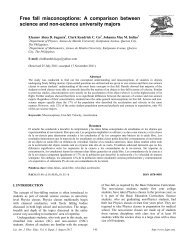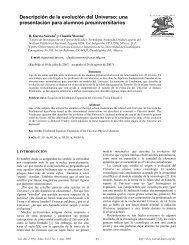An alternative tool to explain Hooke's Law and
An alternative tool to explain Hooke's Law and
An alternative tool to explain Hooke's Law and
You also want an ePaper? Increase the reach of your titles
YUMPU automatically turns print PDFs into web optimized ePapers that Google loves.
<strong>An</strong> <strong>alternative</strong> <strong><strong>to</strong>ol</strong> <strong>to</strong> <strong>explain</strong> Hooke’s <strong>Law</strong> <strong>and</strong><br />
the principle of Dynamometer: The rubber b<strong>and</strong><br />
Gül Ünal Çoban 1 , Serap Kaya Şengören 2 , Seda Korkubilmez 1<br />
1 Buca Faculty of Education, Department of Science Education,<br />
Dokuz Eylul University, Turkey.<br />
2 Buca Faculty of Education, Department of Physics Education,<br />
Dokuz Eylul University, Turkey.<br />
E-mail: gul.unal@deu.edu.tr<br />
(Received 23 November 2010; accepted 11 February 2011)<br />
Abstract<br />
In this experiment, behaviors of the elastic materials when exerted a force were interpreted through the graphs where<br />
the elasticity coefficient of the rubber b<strong>and</strong> was calculated. At the same time, the reason for using an elastic material<br />
inside the dynamometer <strong>and</strong> the limits of elasticity were discussed by two different demonstrations conducted with<br />
rubber b<strong>and</strong>.<br />
Key Words: Hooke' s law, dynamometer, rubber b<strong>and</strong>.<br />
Resumen<br />
En este experimen<strong>to</strong>, los comportamien<strong>to</strong>s de los materiales elásticos cu<strong>and</strong>o se ejerce una fuerza fueron interpretados<br />
a través de los gráficos, donde se calculó el coeficiente de elasticidad de la goma elástica. Al mismo tiempo, la razón<br />
para el uso de un material elástico en el interior del banco y los límites de elasticidad fueron examinados por dos<br />
manifestaciones diferentes realizados con la b<strong>and</strong>a de goma.<br />
Palabras clave: Ley de Hooke, dinamómetro, b<strong>and</strong>a de goma.<br />
PACS: 01. 40. Fk, 01.40.gb, 01.50.Pa ISSN 1870-9095<br />
I. INTRODUCTION<br />
basic principle of dynamometer, the properties of elastic<br />
materials <strong>and</strong> the limits of elasticity at the primary <strong>and</strong><br />
Gravity is one of the fundamental forces in the universe. We<br />
know that when an object is subjected <strong>to</strong> external forces,–<br />
such as gravity- its size or shape, or both change depending<br />
secondary education level.<br />
on its a<strong>to</strong>mic bonding structure or elasticity. For example, a<br />
spring undergoes change in size <strong>and</strong> shape through<br />
II. BASIC PRINCIPLE<br />
compression or extension. You may experience such kind of The elastic materials can be outstretched in dimension by<br />
change when you jump in<strong>to</strong> bed as the bedsprings are exerting force on <strong>and</strong> they can return back <strong>to</strong> their original<br />
compressed by your weight exerted on it [1]. The thing <strong>to</strong> be positions when that force is removed.<br />
highlihted in this example is that the compression of the There is a linear relationship between the tensile force<br />
bedsprings is directly proportional <strong>to</strong> the the weight applied exerted on the material <strong>and</strong> the amount of stretching<br />
showing the Hook’s <strong>Law</strong>. In most of the basic physics according <strong>to</strong> the Hook’s <strong>Law</strong>. This relation in one dimension<br />
labora<strong>to</strong>ries, generally the springs are used for the purpose of<br />
showing especially the Hook’s <strong>Law</strong> <strong>and</strong> modeling the elastic<br />
can be shown by the following equation:<br />
materials [2, 3]. In this experiment, we would like <strong>to</strong> propose<br />
“the rubber b<strong>and</strong>” that can be used for the Hook’s <strong>Law</strong> <strong>and</strong><br />
F k x . (1)<br />
some spring based experiments [4, 5] we used rubber b<strong>and</strong><br />
because it is extremely flexible as it can be stretched up <strong>to</strong> a<br />
few hundred per cent without breaking <strong>and</strong> also it<br />
completely recovers <strong>and</strong> contracts <strong>to</strong> its original length after<br />
releasing the deforming force as stated by Euler [6, p. 58].<br />
Morever it is simple, cheap <strong>and</strong> can easily be obtained. This<br />
experiment will discuss the discovery of Hook’s <strong>Law</strong>, the<br />
In the above equation, k <strong>and</strong> x st<strong>and</strong> for the elasticity<br />
coefficient <strong>and</strong> the amount of extension in length of the<br />
elastic material when the force is exerted on compared <strong>to</strong> the<br />
length when no force is exerted on respectively.<br />
Lat. Am. J. Phys. Educ. Vol. 5, No. 1, March 2011 167 http://www.lajpe.org
Gül Ünal Çoban Serap Kaya Şengören <strong>and</strong> Seda Korkubilmez<br />
III. APPARATUS AND EXPERIMENT<br />
The <strong><strong>to</strong>ol</strong>s required for the experiment are a wooden ruler of<br />
30cm, 3 identical rubber b<strong>and</strong>s which are st<strong>and</strong>ard in type<br />
<strong>and</strong> length, a paper clip, 5 different mass up <strong>to</strong> 150gr (the<br />
measurements done with the rubber b<strong>and</strong> used in this<br />
experiment gave fine results up <strong>to</strong> the mass of 150gr), a pan<br />
(20gr), a fixed base, two iron rods <strong>and</strong> an affixing.<br />
The system shown in Figure 1 was set up by passing a<br />
rubber b<strong>and</strong> on the paper clip. The pan can be hanged on the<br />
rubber b<strong>and</strong> in order <strong>to</strong> put the masses easily. After passing<br />
the rubber b<strong>and</strong> on the paper clip, record the initial lentgh of<br />
the rubber b<strong>and</strong> (x0). Afterwards, switch the mass of 30gr<br />
(with <strong>to</strong>tal mass of 50gr including the mass of the pan <strong>to</strong> the<br />
rubber b<strong>and</strong>. This time, the rubber b<strong>and</strong> starts <strong>to</strong> extend until<br />
the res<strong>to</strong>ring force gets equal <strong>to</strong> the gravitational force<br />
exerting on the mass. Record the amount of extension in<br />
length (x). In this situation, the first equation can be written<br />
as the following:<br />
Mg k x , (2)<br />
2<br />
“g” ( g 9,8 m / s ) is the free-fall acceleration.<br />
FIGURE 1. Experimental setup.<br />
When the other masses (50g, 70g, 90g <strong>and</strong> 110g respectively<br />
including the mass of the pan) were switched respectively,<br />
<strong>to</strong>tal mass <strong>and</strong> the gravitational force increase leading an<br />
increase in the amount of extension in length. This situation<br />
is shown in Table I clearly.<br />
The experiment is repeated orderly with the same masses<br />
but this time putting over the two rubber b<strong>and</strong>s respectively<br />
on the initial rubber b<strong>and</strong> (so as <strong>to</strong> increase the thickness of<br />
the rubber b<strong>and</strong> gradually) for switching the masses. By this<br />
way, as the number or the thickness of the rubber increase<br />
the amount of extension in length decrease for the same<br />
mass. This situation can be seen when the Tables I, II <strong>and</strong> III<br />
were compared <strong>to</strong> each other.<br />
TABLE I. The switched masses when there is only one rubber<br />
b<strong>and</strong> (M), the corresponding gravitational forces <strong>to</strong> these masses<br />
G=mg, the length of the rubber b<strong>and</strong> (x) <strong>and</strong> the amount of<br />
extension in length x= x-x0.<br />
M (kg) G (N) x0(m) x (m) x (m)<br />
0,05 0,05.g 0,07 0,084 0,014<br />
0,07 0,07.g 0,07 0,088 0,018<br />
0,09 0,09.g 0,07 0,092 0,022<br />
0,11 0,11.g 0,07 0,096 0,026<br />
0,13 0,13.g 0,07 0,100 0,030<br />
0<br />
0 0.005 0.01 0.015 0.02 0.025 0.03<br />
Lat. Am. J. Phys. Educ. Vol. 5, No. 1, March 2011 168 http://www.lajpe.org<br />
G(xg)(N)<br />
0.14<br />
0.12<br />
0.1<br />
0.08<br />
0.06<br />
0.04<br />
0.02<br />
Δx(m)<br />
FIGURE 2. The amount of extension of rubber b<strong>and</strong> corresponding<br />
<strong>to</strong> the gravitational force exerted on only one rubber b<strong>and</strong>.<br />
k<br />
0,13g 0, 05g 0,8.9,8<br />
0, 030 0, 014 0, 016<br />
490 N/m. (3)<br />
TABLE II. The switched masses when there are two rubber b<strong>and</strong>s<br />
(M), the corresponding gravitational forces <strong>to</strong> these masses G=mg,<br />
the length of the rubber b<strong>and</strong> (x) <strong>and</strong> the amount of extension in<br />
length x= x-x0.<br />
M (kg) G (N) x0(m) x (m) x (m)<br />
0,05 0,05.g 0,07 0,077 0,007<br />
0,07 0,07.g 0,07 0,079 0,009<br />
0,09 0,09.g 0,07 0,081 0,011<br />
0,11 0,11.g 0,07 0,083 0,013<br />
0,13 0,13.g 0,07 0,085 0,015
G(xg)(N)<br />
0.14<br />
0.12<br />
0.1<br />
0.08<br />
0.06<br />
0.04<br />
0.02<br />
0,14<br />
0,12<br />
0,1<br />
0,08<br />
0,06<br />
0,04<br />
0,02<br />
0<br />
0 0.005 0.01 0.015 0.02<br />
0<br />
Δx(m)<br />
FIGURE 3. The amount of extension of rubber b<strong>and</strong> corresponding<br />
<strong>to</strong> the gravitational force exerted on two rubber b<strong>and</strong>s connected in<br />
parallel.<br />
k=<br />
0,13g 0, 05 g 0,8.9,8<br />
0, 015 0, 007 0, 008<br />
0 0,002 0,004 0,006 0,008 0,01 0,012<br />
<strong>An</strong> <strong>alternative</strong> <strong><strong>to</strong>ol</strong> <strong>to</strong> <strong>explain</strong> Hooke’s <strong>Law</strong> <strong>and</strong> the principle of Dynamometer: The rubber b<strong>and</strong><br />
In this case, the measurements should be more sensitive<br />
by using more precise measurement <strong><strong>to</strong>ol</strong>s such as Verrnier<br />
caliper <strong>and</strong> micrometer.<br />
980 N/m. (4)<br />
TABLE III. The switched masses when there are three rubber<br />
b<strong>and</strong>s (M), the corresponding gravitational forces <strong>to</strong> these masses<br />
G=mg, the length of the rubber b<strong>and</strong> (x) <strong>and</strong> the amount of<br />
extension in length x= x-x0.<br />
M (kg) G (N) x0(m) x (m) x (m)<br />
0,05 0,05.g 0,07 0,075 0,005<br />
0,07 0,07.g 0,07 0,076 0,006<br />
0,09 0,09.g 0,07 0,077 0,007<br />
0,11 0,11.g 0,07 0,079 0,009<br />
0,13 0,13.g 0,07 0,080 0,010<br />
FIGURE 4. The amount of extension of rubber b<strong>and</strong> corresponding<br />
<strong>to</strong> the gravitational force exerted on three rubber b<strong>and</strong>s connected<br />
in parallel.<br />
As seen in the last graph, the data taken from 3 rubber b<strong>and</strong>s<br />
<strong>to</strong>gether are in the linear line. This graph is approximately<br />
linear. However, as the number of rubber b<strong>and</strong>s increases<br />
their extension length decreases by using the same masses is<br />
the reason for this situation that reduces the precision of the<br />
measurement.<br />
IV.SUGGESTED ANALYSIS AND DEMONSTRA-<br />
TIONS<br />
The students can draw different graphs by using the above<br />
data <strong>and</strong> discuss the results. The students are asked <strong>to</strong><br />
calculate the gravitational force <strong>and</strong> the extension amount of<br />
the rubber b<strong>and</strong> in each system; <strong>and</strong> also draw the graph of<br />
the extension amount of the rubber b<strong>and</strong> depending on the<br />
gravitational force. The graphs drawn depending on the data<br />
in Tables I, II <strong>and</strong> III were shown in Figures 1, 2 <strong>and</strong> 3<br />
respectively. These graphs are almost linear <strong>and</strong> in consistent<br />
with the equation 1. The students are also asked <strong>to</strong> calculate<br />
the coefficient of elasticity for each system by using these<br />
graphs. These coefficients which can easily be calculated<br />
from the inclination of the graphs were given under the<br />
graphs.<br />
The students are asked <strong>to</strong> show by drawing graphs that<br />
what kind of relation exists between the number of parallel<br />
connected rubber b<strong>and</strong>s (the thickness) <strong>and</strong> the extension<br />
amount. This graph can easily be drawn by considering the<br />
extension length in the tables for any mass.<br />
At the end of this experiment, the students are asked <strong>to</strong><br />
compare the weights of various masses switched on 10cm<br />
long sewing yarn <strong>and</strong> 2 identical rubber b<strong>and</strong>s (Figure 5). In<br />
this way, depending on their daily experiences, the students<br />
are able <strong>to</strong> compare the weights of two different masses by<br />
means of comparing the extension amount in elastic<br />
materials. However, they are not able <strong>to</strong> interpret about the<br />
mass switched on the sewing yarn, since the sewing yarn can<br />
not extend in observable manner. At the end of this<br />
demonstration, why an elastic material is used inside the<br />
dynamometers is discussed.<br />
FIGURE 5. Experimental setup.<br />
Lat. Am. J. Phys. Educ. Vol. 5, No. 1, March 2011 169 http://www.lajpe.org
Gül Ünal Çoban Serap Kaya Şengören <strong>and</strong> Seda Korkubilmez<br />
<strong>An</strong>other demonstration may take place by switching a<br />
1000gr mass on a single rubber b<strong>and</strong> that will break off it<br />
(Warning: avoid from the rubber b<strong>and</strong> that probably will<br />
dash out). By the end of this demonstration, the limits of the<br />
elasticity of the elastic matter may be discussed. At that<br />
moment, the students are asked about how the system should<br />
be changed in order <strong>to</strong> measure the weight of this mass. In<br />
here, the students probably think by using the results of the<br />
previous experiment that more rubber b<strong>and</strong>s should be added<br />
<strong>to</strong> that single one or the thickness of the rubber b<strong>and</strong> <strong>and</strong><br />
therefore the coefficient of elasticity should be increased.<br />
V. CONCLUSION<br />
As a result, the extension amount of the elastic materials<br />
increases as the force exerted on them increases, the<br />
extension amount decreases as the thickness (coefficient of<br />
elasticity) of the material increases.<br />
Parallel connection of the elastic materials would<br />
increase the coefficient of elasticity. Elastic materials have<br />
an elasticity limit <strong>and</strong> exceeding this limit will affect the<br />
elastic properties of matter.<br />
This experiment is designed <strong>to</strong> help students improve<br />
various skills. These are measuring, tabulating, drawing<br />
graphs, discovering through thinking on Hook’s <strong>Law</strong>,<br />
establishing cause-effect relationship by considering the<br />
elastic properties of the materials used in dynamometers,<br />
discussing on the limit cases of elasticity <strong>and</strong> deformation<br />
<strong>and</strong> etc. This experiment can easily be set up by using the<br />
materials which can easily be obtained. Therefore, this<br />
experiment can be used in science <strong>and</strong> physics labora<strong>to</strong>ries in<br />
primary <strong>and</strong> secondary levels.<br />
REFERENCES<br />
[1] Hewitt, P. G., Conceptual Physics, 10 th ed., (Addison –<br />
Wesley Publishing, San Francisco, 2006).<br />
[2] Larry F. W. <strong>and</strong> Freda R. F., A simple experiment for<br />
determining the Elastic Constant of a Fine Wire, Physics<br />
Teacher 45, 224-227 (2007).<br />
[3] Serrna, J. D., Joshi, A, Studying springs in series using a<br />
single spring,Physics Education 46, 33-40 (2011).<br />
[4] Struganova, I., A Spring, Hooke’s <strong>Law</strong>, <strong>and</strong> Archimedes’<br />
Principle, Physics Teacher 43, 516-518 (2005).<br />
[5] Hewitt, P. G., Suchocki, J. <strong>and</strong> Hewitt, L., Labora<strong>to</strong>ry<br />
Manual: Conceptual Physical Science 2nd ed., (Addison –<br />
Wesley Publishing, San Francisco, 2009) p. 17.<br />
[6] Euler, M., Hooke’s law <strong>and</strong> material science projects:<br />
exploring energy <strong>and</strong> entropy springs, Physics Education 43,<br />
57-61 (2008).<br />
Lat. Am. J. Phys. Educ. Vol. 5, No. 1, March 2011 170 http://www.lajpe.org



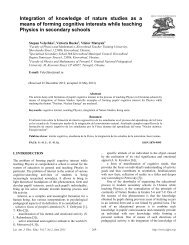
![Diversas formas de visualizar estados en un sistema cuántico [PDF]](https://img.yumpu.com/51151303/1/190x245/diversas-formas-de-visualizar-estados-en-un-sistema-cuantico-pdf.jpg?quality=85)

![Precession and nutation visualized [PDF]](https://img.yumpu.com/50786044/1/190x245/precession-and-nutation-visualized-pdf.jpg?quality=85)
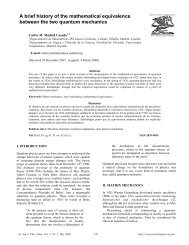
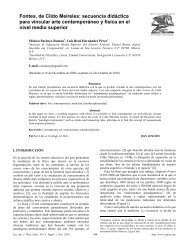
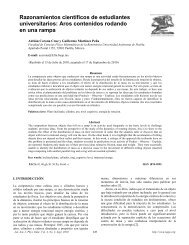

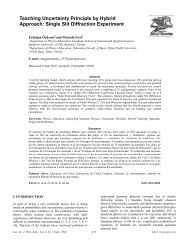
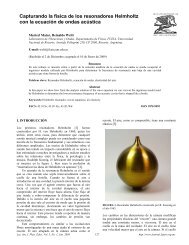
![Index [PDF] - Latin-American Journal of Physics Education](https://img.yumpu.com/47984121/1/190x245/index-pdf-latin-american-journal-of-physics-education.jpg?quality=85)
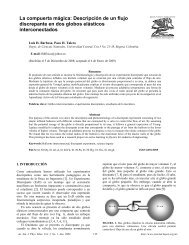
![Flujo de agua en botellas como experimento didáctico [PDF]](https://img.yumpu.com/43536300/1/190x245/flujo-de-agua-en-botellas-como-experimento-didactico-pdf.jpg?quality=85)
